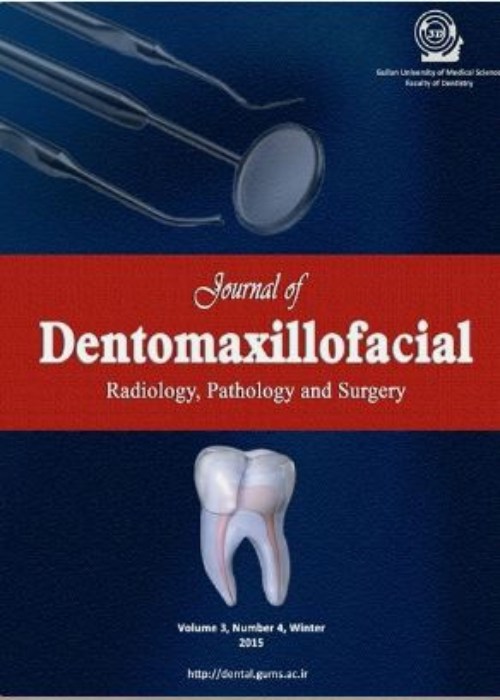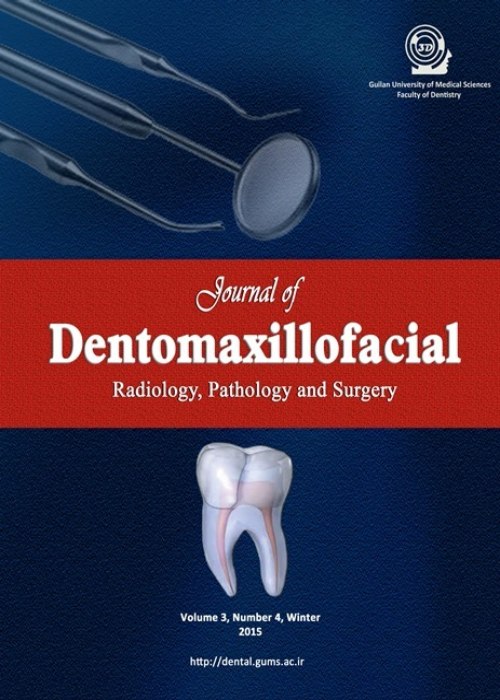فهرست مطالب

Journal of Dentomaxillofacil Radiology, Pathology and Surgery
Volume:12 Issue: 2, Spring 2023
- تاریخ انتشار: 1402/06/30
- تعداد عناوین: 6
-
-
Pages 1-7Introduction
Anxiety about dentistry is one of the most important reasons for people to avoid dental care and in the long run reduces the level of oral health and quality of life. This study investigates the level of anxiety about dentistry and its related factors in adult patients
referred to the School of Dentistry of Karaj University of Medical Sciences in 2021Materials and MethodsIn this descriptive study, was performed on 200 patients referred to the School of Dentistry of Alborz University of Medical Sciences. For information Dental Anxiety Questionnaire (Corah (DAS)) and Question Individual Satisfaction Letter of Quality
of Life (MC. Grath) have been used. Data were analyzed using SPSS software version24ResultsOut of 200 patients, 91 (45.5%) had no anxiety, 13 (6.5%) had mild anxiety, 62 (31%) had moderate anxiety and 34 (17%) had they were very anxious. In this study, women were more anxious than men. There was a relationship between anxiety and satisfaction with the quality of life so people who were satisfied with their quality of life had less anxiety.
ConclusionThe results showed a significant relationship between dental anxiety and related factors such as gender, age, education, life satisfaction and number of visits to the dentist.
Keywords: Anxiety Disorders, Personal Satisfaction, Oral Health -
Pages 8-18
Aims|:
Tooth color is an important factor in smile esthetics. The present study aimed to evaluate the efficacy of three different whitening mouth rinses on color recovery of teeth with surface staining.
Materials and methodsThirty-two bovine incisors were used in this invitro study. First, the teeth were stained by being immersed in a tea solution for 14 days and then randomly assigned to four groups based on the type of mouth rinse used (n=8): C: control (distilled water); ZSW: Zenon Smart White (containing pyrophosphate and triphosphate); PCW: Pasta del Capitano Whitening (containing Plasdone); SWN: Signal White Now (containing Blue Covarine). Colorimetry was carried out using a spectrophotometer at baseline, after staining, and 2, 4, 8, and 12 weeks after immersion in mouth rinses. The data were analyzed with CIELab parameters and ANOVA, repeated measures ANOVA, and Tukey tests (α=0.05).
ResultsThe mouth rinses decreased tooth staining. The mouth rinses resulted in significant color changes compared to the controls (Ppcw=0.028 and Pzsw=0.002), except for the SWN mouth rinse. The color recovery of the teeth by ZSW mouth rinse, compared to the baseline, was in the clinically acceptable range (ΔE<3.3), and the difference from the control group was borderline (P=0.05).
ConclusionA relative recovery of tooth colors was only achieved using the ZSW mouth rinse, which contains pyrophosphate and triphosphate compounds.
Keywords: Metalloporphyrins, Color Perception, copolyvidonum PlasdoneS-630, Mouthwashes, Tooth Bleaching -
Pages 19-24Introduction
Early diagnosis and interceptive treatment of the maxillary canine impaction is crucial as it reduces treatment complexity and decreases complications and adverse outcomes. The aim of the study was to the prediction of impacted maxillary canines, and early diagnosis by using panoramic.
Materials and MethodsThis investigation was a cross-sectional study performed on 385 panoramic radiographs, which were evaluated to assess the position of canines. Two methods Ericson and Kurol (EK/L) and the Power and Short (PS) geometric measurement analyses used in each radiograph. Thus, the prevalence was calculated from each method. The normality of the data was subsequently analyzed by application of a one-sample non-parametric Kolmogorov-Smirnov test. Thereafter, Fisher’s exact and Mann-Whitney U tests were conducted to determine differences in the permanent tooth impaction of the subjects.
ResultsFive permanent canines were classified as high risk through the EK/L method. While the PS method was used, 20 high risks of impaction were found. The statistical difference is detected between the right and left sides. It was found statistical difference detected between EK/L and Ps methods (p = 0.004).
ConclusionThe EK/L method determined a canine impaction prevalence on pa noramic radiographs of 1.3%, while in the PS Method, the prevalence was 5. 2%. In addition, a significant predilection of canine impaction to the gender was not found.
Keywords: Animals, Humans, Radiography-Panoramic, Algorithms -
Pages 25-35Introduction
The present study aimed to assess the prevalence of periodontal bony lesions in radiographs in the Iranian population.
Materials and MethodsIn this analytical cross-sectional study, 440 radiographic images of patients aged 15-60 years were selected based on the study’s inclusion criteria. Two researchers evaluated all radiographs and recorded patient age, gender, and bone-related lesions (horizontal , vertical and furca involvement) in a checklist. Chi-square test was used for data analysis. (α=0.05).
Results273 images (62.05%) had no lesions and 167 images (37.95%) had lesions. In the 167 examined images, a total of 845 bone lesions were observed . The highest frequency was in horizontal lesions in the anterior mandible and central incisor teeth and the lowest type of lesion was related to vertical lesions in the posterior mandible and in the third molar (P<0.001). The most types of bone lesions; Based on the type of tooth, was related to horizontal lesions in the lateral incisor and the lowest type of lesion was related to vertical lesions in the first premolar tooth (P<0.001). Based on restoration, the most related to horizontal lesions in amalgam and the least related to vertical lesions and furca in veneer (P<0.001). Based on the contact status, the most was related to horizontal lesions in open contact and the least was related to vertical lesions (P<0.001).
ConclusionBased on this study, there is a significant association between the type of periodontal bony lesion and involved teeth, restoration type, contact status, presence of calculus on radiographs.
Keywords: Periodontal Diseases, Alveolar Bone Loss, Radiography, Panoramic, Furcation Defects -
Pages 36-41
Osteoma is a slow-growing benign osteogenic tumor. Osteomas can be central, peripheral, and extra-skeletal. The prevalence of extra-skeletal osteoma often found in muscles is very low. Osteomas unrelated to the syndrome often occur as solitary tumors, but sometimes multiple osteomas are unrelated to the syndrome. Here, we report a rare non-syndromic craniofacial osteoma, a combination of skeletal and extra-skeletal types. During mastication, the patient complained of dull pain in the right maxillary molar area. Panoramic and CBCT showed multiple homogenous opacities on the right mandibular body and condylar neck, as well as in the right infratemporal fossa and masticator space, having a pressure effect on the base of the skull. A biopsy of the mass on the mandibular body confirmed osteoma. The absence of the other manifestations of Gardner syndrome made the patient a rare case of multiple non-syndromic osteomas.
Keywords: Osteoma, Mandible, Infra-temporal fossa -
Pages 42-51Introduction
The aim of this study was to determine the accuracy of digital panoramic radiography in estimating the height of bone between alveolar crest and anatomical landmarks of both jaws( maxillary sinus and inferior alveolar nerve canal) in molar and premolar areas in comparison with CBCT.
Methods and MaterialsA total of 217 samples from patients who had both digital panoramic radiographs and CBCT before implant insertion were selected. Shortest distance between alveolar crest and IANC (of mandible), and between the alveolar crest and maxillary sinus (of maxilla) in molar and premolar area has been measured. The differences of these measurements have been analyzed using paired t-test, the Bland-Altman plot and ICC.
ResultsMeasurements of panoramic radiography were significantly greater than CBCT in mandibular premolar and molar area plus maxillary premolar area (p<0.001, p<0.001, p=0.008 respectively), but the results were insignificant in maxillary molar area (p=0.147). By using ICC, the measurements were closely and positively correlated in all areas, with correlation coefficient ranging from 0.916 to 0.947. The Bland-Altman plots showed significant difference between two modalities except maxillary molar area (p<0.05).
ConclusionPanoramic radiographs contain valuable information of both jaws, however they could not be reliable for meticulous measuring such as distance to anatomical regions- except posterior maxillary one - in surgeries. So that, it is essential to use precise 3D systems such as CBCT for implant measurements.
Keywords: Cone-Beam Computed, Tomography, Radiography, Panoramic, Dental Implants


